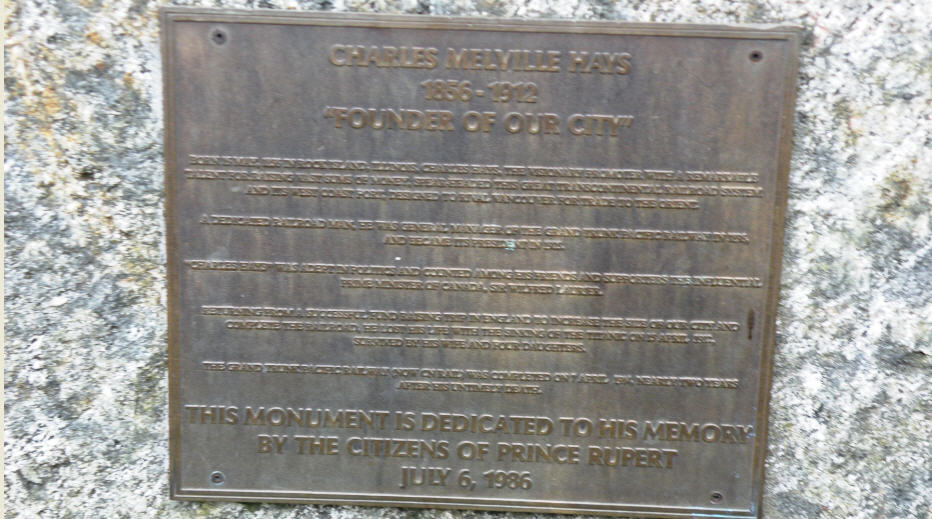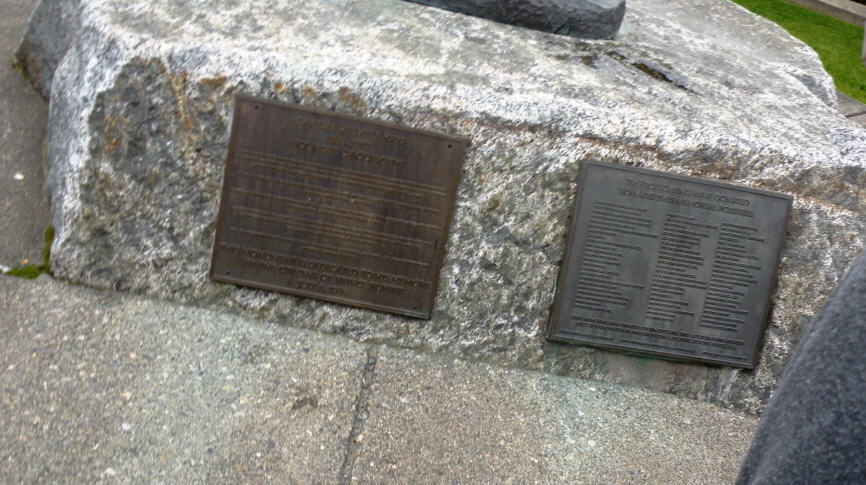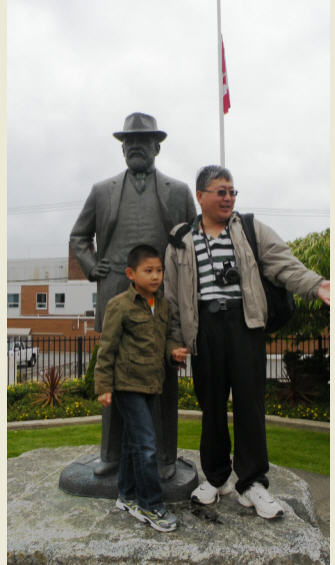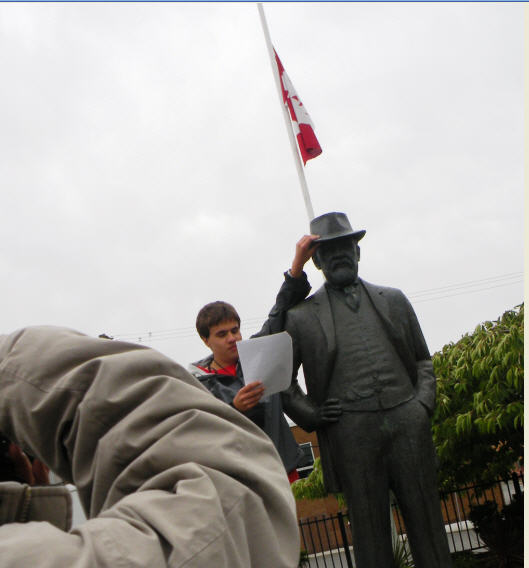博文
HAYS, CHARLES MELVILLE(1856-1912)纪念碑在Prince Rupert
|||
HAYS, CHARLES MELVILLE(1856-1912)纪念碑在Prince Rupert
黄安年文 黄安年的博客/2011年11月9日(美东时间)发布
在加拿大Prince Rupert市区竖立了一块纪念碑,纪念为Prince Rupert建设功勋卓著的HAYS, CHARLES MELVILLE(1856-1912), 1904-1912年他任Grand Trunk Pacific公司董事长。这条铁路的建成对于加拿大的统一和西海岸线的建设具有重要意义。
照片4张是25日即时拍摄的。
*****************************
Dictionary of Canadian Biography Online
Skip to content |Skip to institutional links
Common menu bar links· Français
· Home
· Help
· Search
Item DisplayBrowse by Identification | Browse by Geographical Location | Search
1911-1920 (Volume XIV)
HAYS, CHARLES MELVILLE, railway official; b. 16 May 1856 in Rock Island, Ill.; m. 13 Oct. 1881 Clara J. Gregg in St Louis, Mo., and they had four daughters; d. 15 April 1912 in the North Atlantic, and was buried in Montreal.
Charles M. Hays grew up and received his early education in St Joseph, Mo. At 17 he began work in St Louis with the Atlantic and Pacific Railroad. In 1878 he was appointed secretary to the general manager of the Missouri Pacific and six years later he accepted a similar position with the larger Wabash, St Louis and Pacific. He became general manager of the Wabash Western in 1887 and of the entire Wabash system in 1889.
A reorganization of the Grand Trunk Railway of Canada in 1895 resulted in Hays’s appointment as general manager of that system, effective 1 Jan. 1896, and his move with his family to Montreal. His predecessor, Lewis James Seargeant, became a special adviser to the GTR’s London-based board of directors. With one interruption, in 1901, Hays held his position until 1909, when he was appointed president; he was president as well of the railway’s western Canadian subsidiary, the Grand Trunk Pacific, from 1904 until his death.
He had arrived in Canada at a time of economic depression. The performance of railways had been disappointing for years, although the Canadian Pacific Railway had fared better than the larger, more heavily indebted GTR. Hays was brought in to make major managerial changes – specifically to introduce “American” methods which were more aggressive and less scrupulous than those of British systems. His first responsibility was to restructure the GTR’s administration and operations. Instead of relying only on the reports and recommendations of senior administrators in Britain, he sought the opinions and advice of operating staff in Canada. Traffic exchanges with other systems, the negotiation of running rights, and the modernization of accounting procedures solved many of the practical problems left unaddressed by the head office. Hays was even willing to sell important trackage between Toronto and Hamilton to the rival CPR, but only after the GTR had obtained an advantageous agreement on running rights. The improved efficiency resulting from these reforms coincided with an era of unprecedented growth and enabled him to bring the GTR from a state of near-bankruptcy to one of moderate success. In the process, Hays, a stocky man who invariably appeared well dressed with a neat beard, became known for his unwillingness to tolerate any interference in the way he ran the railway and for his implacable disdain for organized labour, especially during a dispute in Ontario in 1905 and a bitter, system-wide strike in 1910.
After 1896 Canadian prosperity was based on the settlement of the prairies. To compete effectively with the CPR, Hays believed the GTR had to cross them. In 1900 he had advanced a grandiose plan to run the lines of an American subsidiary, the Grand Trunk Western, from Chicago to Winnipeg and thence to the Pacific. The directors in London rejected this proposal and in late 1900 Hays resigned to become president of the Southern Pacific Railroad in the United States as of 1 Jan. 1901. Unfortunately for him, it was taken over by the interests of railway magnate Edward Henry Harriman. Hays disagreed with the new owners and quit; by the end of 1901 he had returned to his old job, and a vice-presidency, at the GTR. In the meantime its board had been persuaded by president Sir Charles Rivers Wilson to adopt an aggressive policy of westward expansion. Significantly too, the federal government of Sir Wilfrid Laurier had decided to promote the building of a second transcontinental railway. On the failure of the GTR and the smaller, prairie-based Canadian Northern to unite on such a project, Ottawa threw its support behind the GTR. On 24 Nov. 1902 Hays formally announced plans to construct a transcontinental.
The Grand Trunk Pacific, Hays’s greatest and most controversial work in Canada, was to consist of two sections: a line west from Winnipeg and a government-built line between Winnipeg and Moncton, N.B., that was to connect with the old Grand Trunk system. Hays was responsible for the construction and operation policies of the new western line. His persistent demands for federal subsidization, however, contributed to bitter discord within Laurier’s cabinet [see Andrew George Blair*], which could not agree on a policy. In May 1903 Hays was joined by president Sir Charles Wilson, who was able to exert greater influence on cabinet; together they formed an effective team, one tough, the other smooth. Hays was willing to promise whatever Wilson thought diplomatically necessary, but he did so only if there were no real means for the government to enforce terms that the GTP might find inconvenient in the future. Nevertheless, his concessions were critically important in meeting specific political difficulties faced by Laurier when he was promoting the transcontinental scheme in parliament that summer and fall. In October the National Transcontinental Railway Act was passed and the GTP was incorporated.
Four aspects of Hays’s GTP policies were particularly problematic. He seriously underestimated the Canadian Northern, whose owners he thought would sell out to him but who, instead, launched vigorous competition. A second, more difficult matter was the commitment of the GTR to the GTP. There were no existing traffic links between the two systems, and the board in London was not willing to give the western project its unqualified support. Nevertheless, Hays, acting without proper authorization from London, committed the parent company in 1903 to conditions which would ultimately ruin the GTP and the Grand Trunk. The selection in 1905 of the site of Prince Rupert, on Kaien Island, B.C., as the western terminal was the third controversial decision supported by Hays. There was little local traffic on the portion of the line in northern British Columbia, only 100 miles of which had been built by 1912, but Hays insisted that it would prove beneficial since it shortened the route to Asia.
A final, disastrous decision involved the priority Hays gave to the construction of the GTP to the highest standards in North America, before a system of feeders had been developed on the prairies. The resulting delay in completion and the lack of competition allowed the CPR and the Canadian Northern to consolidate their holds on traffic on the prairies. Consequently, what was arguably the best main line across western Canada did not attract the volume of freight needed for profitable operation.
Hays did not live to see the GTP completed: he perished in the sinking of the Titanic in 1912. Sanctified by this tragic end and by his high social standing in Montreal, including membership in the American Presbyterian Church, he was eulogized as one of Canada’s greatest railwaymen. On 25 April 1912 work and movement on the GTR’s entire system stopped for five minutes in tribute. Hays’s legacy, however, was mixed. He presided over the most prosperous era in the history of the GTR, but as president of the GTP he initiated policies and programs which led in 1919 to the GTP being placed in receivership and to legislation authorizing federal acquisition of the GTR’s capital stock. During the proceedings of the board appointed to value this stock, it was alleged that Hays had deceived the London directors in 1903 and that they had never knowingly endorsed the scheme that led to the insolvency and nationalization of the entire system.
Much of the information in this biography was drawn from the Hays papers at NA, MG 30, A18 (transcripts), and from articles in contemporary railway journals, in particular the Railway and Shipping World (Toronto), 1898–1905, and its successor, the Railway and Marine World, 1906–12.
Gazette (Montreal), 19, 22–23, 26 April 1912. Canadian annual rev. (Hopkins). Canadian men and women of the time (Morgan; 1898 and 1912). A. W. Currie, The Grand Trunk Railway of Canada (Toronto, 1957). Encyclopaedia of Canadian biography . . . (3v., Montreal and Toronto, 1904–7), 1. Frank Leonard, A thousand blunders: the Grand Trunk Pacific Railway and northern British Columbia (Vancouver, 1996). Donald MacKay, The people’s railway; a history of Canadian National (Vancouver and Toronto, 1992). Gavin Murphy, “Canada’s forgotten railway tycoon,” Beaver, 73 (1993–94), no.6: 29–36. T. D. Regehr, The Canadian Northern Railway, pioneer road of the northern prairies, 1895–1918 (Toronto, 1976). Standard dict. of Canadian biog. (Roberts and Tunnell), vol.1. G. R. Stevens, Canadian National Railways (2v., Toronto and Vancouver, 1960–62), 2.
Business, Business -- Transportation
North America, North America -- Canada, North America -- Canada -- Quebec, North America -- Canada -- Quebec -- Montréal/Outaouais, North America -- United States of America
http://www.biographi.ca/EN/ShowBio.asp?BioId=41552 ***************** Charles M. Haysaus Wikipedia, der freien Enzyklopädie
Wechseln zu: Navigation, Suche
Charles M. Hays
Charles Melville Hays (* 16. Mai 1856 in Rock Island, Illinois, USA; † 15. April 1912 im Nordatlantik) war ein US-amerikanischer Eisenbahnunternehmer und zuletzt Präsident der Grand Trunk Railway. Er überwachte den Bau der Grand Trunk Pacific Railway, zu deren Präsident er 1904 ernannt wurde. Die Einweihung erlebte er jedoch nicht mehr, da er 1912 beim Untergang der Titanic ums Leben kam.
| Inhaltsverzeichnis |
Charles M. Hays kam 1856 in der Stadt Rock Island in Illinois an der Grenze zu Iowa zur Welt. 1873 begann er im Alter von 17 Jahren, für die Atlantic and Pacific Railroad zu arbeiten. 1878 wurde er Sekretär des Geschäftsführers der Missouri Pacific Railroad und 1884 nahm er dieselbe Position bei der Wabash, St. Louis and Pacific Railway ein. 1887 stieg er zum Geschäftsführer der Unterabteilung Wabash Western Railroad und 1889 zum Geschäftsführer der gesamten Wabash, St. Louis and Pacific Railway auf.
Hays lebte viele Jahre in Kanada und arbeitete dort für die Grand Trunk Railway, einer der damals größten Eisenbahngesellschaften Kanadas. Bei einer Neuorganisation des Unternehmens im Jahr 1895 wurde er mit Wirkung vom 1. Januar 1896 zum Geschäftsführer ernannt. Bis auf eine kurze Unterbrechung 1901 hatte Hays von 1899 bis 1910 die Position des Geschäftsführers inne. Ab dem 1. Januar 1910 war er Präsident des gesamten Unternehmens.
Hays ging während einer Zeit der wirtschaftlichen Rezession nach Kanada. Sein Plan war es, das Management und die Arbeitsweise der Grand Trunk Railway in eine angriffslustigere, US-nahe Richtung zu lenken. Das Wachstum des amerikanischen Eisenbahnwesens in der ersten Hälfte des 20. Jahrhunderts wird unter anderem dieser Tatsache zugeschrieben. Außerdem wollte er der Canadian Pacific Railroad Konkurrenz machen, die durch einen Einwanderungsboom in den ländlichen Regionen Rekordzahlen bei der Passagierbeförderung verzeichnete.
1907 wurde Charles Hays mit dem höchsten Orden Japans, dem Orden der Aufgehenden Sonne, ausgezeichnet. 1910 wurde ihm die Ritterschaft angeboten, was ihn zu Sir Charles Hays gemacht hätte. Er lehnte diese Ehrung jedoch ab, da sie den Verlust seiner US-amerikanischen Staatsbürgerschaft zur Folge gehabt hätte. Hays interessierte sich auch für das Gesundheits-, und Bildungswesen und für wohltätige Zwecke. Er unter anderem Vorsteher des Montreal General Hospital, des Royal Victoria Hospital und der McGill University in Montreal.
Bau der transkontinentalen Eisenbahnstrecke [Bearbeiten]1899 schlossen die beiden kanadischen Eisenbahnunternehmer Sir William Mackenzie und Sir Donald Mann mehrere kleinere Eisenbahngesellschaften zur Canadian Northern Railway zusammen und planten den Bau einer zweiten transkontinentalen Eisenbahnverbindung. Finanzielle Unterstützung durch die kanadische Regierung lehnten sie jedoch ab, da sie es aus eigenen Kräften schaffen wollten. Auf Druck von Hays nahm die Grand Trunk Railway staatliche Unterstützung an, was sie noch in den 1870ern strikt abgelehnt hatte. Durch diese Tatsache hatte sich die Regierung damals der Canadian Pacific Railroad zugewandt. Da er erkannte, dass es ein Fehler war, nicht in den Westen zu expandieren, nahm Hays das Angebot der Regierung an, eine Eisenbahnstrecke von Prince Rupert in British Columbia (kanadische Westküste) nach Moncton in New Brunswick (kanadische Ostküste) zu bauen. Diese Strecke sollte den Namen Grand Trunk Pacific Railway tragen.
Im Oktober 1903 passierte der National Transcontinental Railway Act das kanadische Parlament. Hays war daraufhin in die Beaufsichtigung des Baus des Streckenabschnitts westlich von Winnipeg involviert. Grand Trunk hatte die Verantwortung für den westlichen Teil der Strecke übernommen, während die Regierung den östlichen Teil von Winnipeg nach Moncton übernahm, darunter den kostspieligen Bau der Quebec Bridge über dem Sankt-Lorenz-Strom. Die gesamte Verbindung sollte jedoch von der Grand Trunk Railway als ein System verwaltet werden. 1904 wurde Hays zum Präsidenten der Grand Trunk Pacific Railway ernannt.
Der Spatenstich für das Bauvorhaben wurde am 11. September 1905 in Fort William in Ontario durch Premierminister Wilfrid Laurier vorgenommen. Von dort aus wurde durch die Grand Trunk Pacific Construction Company ein 190 Meilen langer Streckenabschnitt bis in die Nähe von Sioux Lookout gebaut. Das Projekt erwies sich als kontrovers und Hays für einige seiner Entscheidungen kritisiert, darunter die Wahl von Prince Rupert als Endstation. Auch der Finanzierung haperte es trotz staatlicher Zuwendung. Ende des Jahres 1911 hatte das Unternehmen Schulden in Millionenhöhe. Mehrere neue Vorhaben sollten Grand Trunk wieder in die roten Zahlen bringen, darunter der Bau einer Kette von Luxushotels in Kanada. Hays hatte bereits das Château Laurier in Ottawa gebaut und sechs weitere waren in Planung, darunter das Fort Garry in Winnipeg und das Hotel Macdonald in Edmonton
Trotz der Schwierigkeiten konnte die Strecke fertig gestellt werden, jedoch erst im April 1914, zwei Jahre nach Hays‘ Tod.
Privatleben [Bearbeiten]Am 13. Oktober 1881 heiratete Hays in St. Louis, Missouri die 22-jährige Clara Jennings Gregg, die aus dieser Stadt stammte. Sie bekamen vier Töchter: Orian (später Mrs. Thornton Davidson), Clara (Mrs. Hope C. Scott), Marjorie (Mrs. George D. Hall) und Louise (Mrs. A. Harold Grier).
Im Jahr 1912 verbrachte Charles Hays die Osterfeiertage mit seiner Frau, seiner Tochter Orian und seinem Schwiegersohn Thornton Davidson in Paris. Da er an der feierlichen Eröffnung des Château Laurier am 26. April 1912 in Ottawa teilnehmen sollte, ging die Gruppe am 10. April 1912 in Southampton an Bord der RMS Titanic, dem bis dahin größten Schiff der Welt, das zu seiner Jungfernfahrt nach New York in See stach. Ein weiterer Grund für die Rückreise war die schwierige Schwangerschaft der Hays-Tochter Louise Grier, der möglicherweise ein Kaiserschnitt bevor stand.
Die Gruppe belegte insgesamt vier Kabinen der Ersten Klasse auf dem B-Deck. Das Ehepaar Hays bewohnte die Kabine B-69 und das Ehepaar Davidson die Nachbarkabine B-71. Clara Hays‘ Dienstmädchen Mary Perreault war in B-73 untergebracht und Charles Hays‘ Sekretär Vivian Payne in B-24. Am Abend des 14. April saß Hays mit Colonel Archibald Gracie und dem Schiffsmagnaten Captain Edward Crosby im Rauchsalon der Ersten Klasse und besprach mit ihnen die rasanten technischen Fortschritte im Transportwesen. Er drückte seine Besorgnis folgendermaßen aus: „Der Trend, immer schneller und leichtlebiger mit immer größeren Schiffen zu spielen, wird in einer Tragödie enden“.
Etwa 20 Minuten später rammte die Titanic den Eisberg. Hays schien nicht davon auszugehen, dass das Schiff schnell sinken würde. Als er seine Frau und seine Tochter in ein Rettungsboot setzte, sagte er ihnen, dass das Schiff noch „mindestens 10 Stunden schwimmfähig sei“. Clara Hays, Orian Davidson und Mary Perreault überlebten im Rettungsboot Nr. 3. Dieses Boot wurde auf der Steuerbordseite zu Wasser gelassen, wo der Erste Offizier William M. Murdoch das Ausbooten überwachte. Im Gegensatz zu Charles Lightoller auf der Backbordseite ließ Murdoch auch Männer in die Boote, wenn nach dem Einsteigen der Frauen und Kinder noch Platz war. Charles Hays, sein Schwiegersohn und sein Sekretär blieben trotzdem an Bord. Alle drei kamen bei dem Untergang ums Leben. Die drei Frauen wurden zusammen mit den anderen Überlebenden an Bord der RMS Carpathia nach New York gebracht, wo das Schiff am 18. April einlief.
Postum [Bearbeiten]Am 25. April 1912 wurde bei der gesamten Grand Trunk Railway eine fünfminütige Schweigepause für den verstorbenen Unternehmenspräsidenten eingelegt. Am darauffolgenden Tag fand der Kabelleger Minia, der neben anderen Schiffen mit der Bergung der Todesopfer beauftragt war, die Leiche von Charles Hays (#307) im Nordatlantik. Am 8. Mai 1912 fand auf dem Friedhof Mont-Royal in Montreal die Beisetzung statt. Am selben Tag wurden in der American Presbyterian Church in Montreal und in der Church of St. Edmund King and Martyr in London Trauerfeiern für Hays abgehalten. Er wurde in der Pine Hill Section des Mount Royal Cemetery (Grab # 246) bestattet.
Die Stadt Melville in der kanadischen Provinz Saskatchewan wurde nach Hays benannt, ebenso die Charles Hays Secondary School in Prince Rupert. Clara Hays blieb unverheiratet und lebte bis zu ihrem Tod 1955 hauptsächlich in Maine. Sie wurde neben ihrem Ehemann bestattet. Auch Orian Davidson wurde nach ihrem Tod 1979 neben ihren Eltern beigesetzt.
Quellen [Bearbeiten]- Ausführliche Biografie von Charles Hays
- Zusammenfassende Details und weiterführende Links in Encyclopedia Titanica
- Artikel über Charles Hays aus dem Montreal, Pictorial and Biographical (1914)
Grand Trunk Pacific Railway
From Wikipedia, the free encyclopedia
Jump to: navigation, search
|
This article needs additional citations for verification. Please help improve this article by adding citations to reliable sources. Unsourced material may be challenged and removed. (January 2008) |
|
Grand Trunk Pacific Railway | |
|
GTP | |
|
Locale |
|
|
Dates of operation |
1914–1920 |
|
Successor |
|
|
4 ft 8 1⁄2 in (1,435 mm) (standard gauge) | |
The Last Spike: Fort Fraser, BC, 1914
The Grand Trunk Pacific Railway (reporting mark GTP) was a historical Canadian railway.
A wholly owned subsidiary of the Grand Trunk Railway (GTR), the GTPR was constructed by GTR using loans provided by the Government of Canada. The company was formed in 1903 with a mandate to build west from Winnipeg, Manitoba to the Pacific coast at Prince Rupert, British Columbia. East of Winnipeg, the federal government would build the National Transcontinental Railway (NTR) across Northern Ontario and Quebec, crossing the St. Lawrence River at Quebec City and ending at Moncton, New Brunswick. The conceptual plan was to have GTR operate both GTPR and NTR as a single transcontinental railway, competing with the Canadian Northern Railway (CNoR) and Canadian Pacific Railway (CPR).
| Contents
[hide] |
At the beginning of the 20th century, the GTR planned a second Canadian transcontinental rail route with a terminal on the Pacific that would be nearer to Asia than Vancouver. It would follow one of the routes surveyed by Sandford Fleming from Winnipeg to Port Simpson at the end of the Portland Canal which formed part of the boundary between British Columbia and Alaska. In 1903 there was resentment in Canada over the Alaska boundary decision which favoured US interests after a British commissioner sided with them. As a result of the clamour in Canada, US President Theodore Roosevelt threatened to send an occupation force to nearby territory. Prime Minister Wilfrid Laurier considered a new location at Prince Rupert would be more easily defended and decided to build the terminal there rather than at Port Simpson.[1]
Turning of the first sod for the construction of the GTPR, took place at an official ceremony, September 11, 1905, at Fort William, Ontario, by Prime Minister Laurier. From there a 190-mile section of track was built by the Grand Trunk Pacific Construction Company, connecting with the NTR, near Sioux Lookout.
Construction began on the Canadian Prairies in 1905, the year that the provinces of Alberta and Saskatchewan were established. Construction proceeded west to Saskatoon, Saskatchewan in 1907, Edmonton, Alberta in 1909, and through Jasper, Alberta into Yellowhead Pass crossing the Continental Divide in 1910-1911. The last spike ceremony heralding completion of the rail line across the prairies, and through the Rocky Mountains to the newly constructed seaport at Prince Rupert, British Columbia was held one mile east of Fort Fraser, British Columbia on April 7, 1914.
In 1910, the company also built a dock in Seattle, the Grand Trunk Pacific dock, which was the largest dock on the west coast at the time it was built. On July 30, 1914, the dock was destroyed by fire.
[edit] OperationsMain article: Last Spike (Grand Trunk Pacific Railway)
The GTPR did not immediately realize the traffic potential GTR and the federal government had hoped. CPR occupied the more populous southern route in the prairies through Regina, Saskatchewan and Calgary, Alberta to Vancouver, British Columbia and was using land grants provided by the federal government as well as government incentives to draw immigrants and businesses to settle along its route. GTR did not have a coordinated marketing plan, and efforts at settlement were disrupted by the First World War. GTR rejected operating the NTR for cost reasons, forcing the federal government to assume that operation into Canadian Government Railways.
By 1919 it was obvious that the GTPR was not paying its way. The financial strain broke on March 7 when GTR defaulted on repayment of construction loans to the federal government, whereby the GTPR was nationalized and taken over by a Board of Management operating under the Department of Railways and Canals while legalities were resolved. On July 12, 1920 the GTPR was placed under the management of Crown corporation Canadian National Railways (CNR) and in 1923 was completely absorbed into the CNR.
The chateau-style hotels of the early 20th century remain iconic Canadian symbols. While the CPR quite rightly receives credit for many of the early hotels of this genre such as The Banff Springs Hotel, The Empress (hotel) in Victoria, The Royal York in Toronto, Hotel Vancouver, Quebec City's Chateau Frontenac and Chateau Lake Louise in The Rockies, it was the GTPR that built Ottawa's Chateau Laurier, The Fort Garry Hotel in Winnipeg, and The Hotel Macdonald in Edmonton. After the nationalization, this tradition continued with construction of The Bessborough Hotel in Saskatoon. The GTPR chateau-style hotels remain among the most impressive of these structures in the country.
[edit] Current statusToday, the majority of the GTPR is still in use as CN's (name change to Canadian National or acronym CN in 1960) main line from Winnipeg to Jasper. West of Jasper, CN's main line swings south on the former Canadian Northern Railway (CNoR) to Vancouver, however the GTPR line to Prince Rupert forms an important CN secondary main line. The GTPR's high construction standards and the fact Yellowhead Pass has the lowest elevation of any railway crossing of the Continental Divide in North America gives the CN a competitive advantage in terms of fuel efficiency and the ability to haul tonnage.
Prince Rupert is the primary marine-railway connection for the Alaska Railroad, and despite having languished as a poor cousin to the Port of Vancouver, there are many opportunities for this port city as a result of the GTPR's foresight a century ago.
The Johnston Terminal at The Forks in Winnipeg was originally a cold storage facility for the Grand Trunk Pacific Railway.[2] Tiles inset into the floors of the building carry the railway's name.
[edit] References1. ^ Hayes, Derek (1999), Historical Atlas of British Columbia and the Pacific Northwest, Vancouver: Cavendish Books, p. 190, ISBN 1-55289-900-4
2. ^ The Forks: Johnston Terminal. Accessed January 25, 2009.
[edit] See also· Grand Trunk Pacific station naming
http://en.wikipedia.org/wiki/Grand_Trunk_Pacific_Railway
https://blog.sciencenet.cn/blog-415-506365.html
上一篇:令人费解的加拿大Prince Rupert 游轮入境签证
下一篇:8岁外孙在电脑上书写:你好外婆



